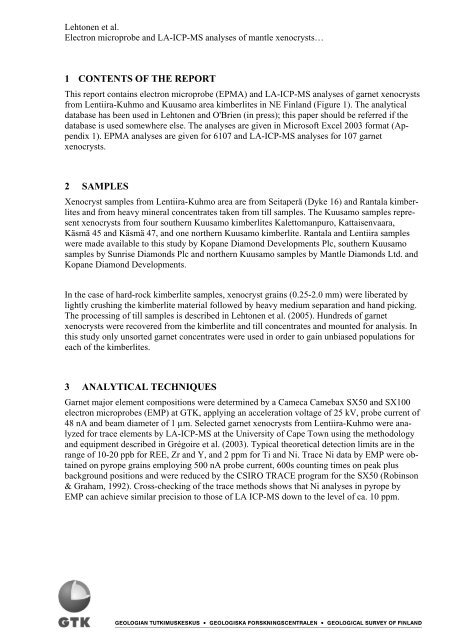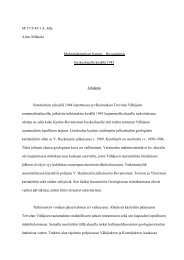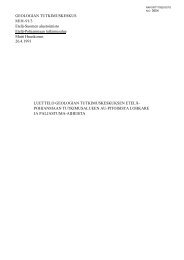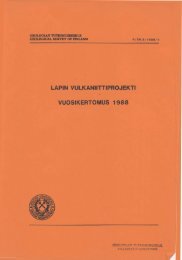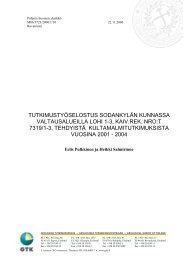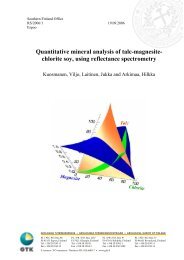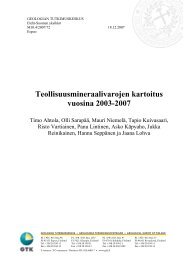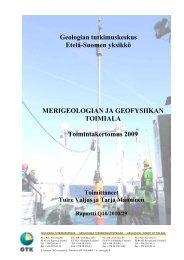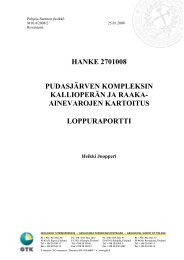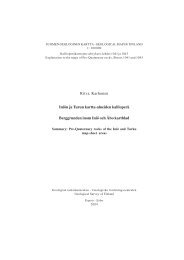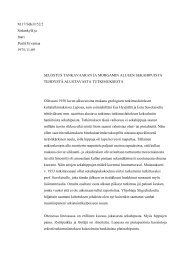Electron microprobe and LA-ICP-MS analyses of ... - Arkisto.gsf.fi
Electron microprobe and LA-ICP-MS analyses of ... - Arkisto.gsf.fi
Electron microprobe and LA-ICP-MS analyses of ... - Arkisto.gsf.fi
- No tags were found...
You also want an ePaper? Increase the reach of your titles
YUMPU automatically turns print PDFs into web optimized ePapers that Google loves.
Lehtonen et al.<strong>Electron</strong> <strong>microprobe</strong> <strong>and</strong> <strong>LA</strong>-<strong>ICP</strong>-<strong>MS</strong> <strong>analyses</strong> <strong>of</strong> mantle xenocrysts…1 CONTENTS OF THE REPORTThis report contains electron <strong>microprobe</strong> (EPMA) <strong>and</strong> <strong>LA</strong>-<strong>ICP</strong>-<strong>MS</strong> <strong>analyses</strong> <strong>of</strong> garnet xenocrystsfrom Lentiira-Kuhmo <strong>and</strong> Kuusamo area kimberlites in NE Finl<strong>and</strong> (Figure 1). The analyticaldatabase has been used in Lehtonen <strong>and</strong> O'Brien (in press); this paper should be referred if thedatabase is used somewhere else. The <strong>analyses</strong> are given in Micros<strong>of</strong>t Excel 2003 format (Appendix1). EPMA <strong>analyses</strong> are given for 6107 <strong>and</strong> <strong>LA</strong>-<strong>ICP</strong>-<strong>MS</strong> <strong>analyses</strong> for 107 garnetxenocrysts.2 SAMPLESXenocryst samples from Lentiira-Kuhmo area are from Seitaperä (Dyke 16) <strong>and</strong> Rantala kimberlites<strong>and</strong> from heavy mineral concentrates taken from till samples. The Kuusamo samples representxenocrysts from four southern Kuusamo kimberlites Kalettomanpuro, Kattaisenvaara,Käsmä 45 <strong>and</strong> Käsmä 47, <strong>and</strong> one northern Kuusamo kimberlite. Rantala <strong>and</strong> Lentiira sampleswere made available to this study by Kopane Diamond Developments Plc, southern Kuusamosamples by Sunrise Diamonds Plc <strong>and</strong> northern Kuusamo samples by Mantle Diamonds Ltd. <strong>and</strong>Kopane Diamond Developments.In the case <strong>of</strong> hard-rock kimberlite samples, xenocryst grains (0.25-2.0 mm) were liberated bylightly crushing the kimberlite material followed by heavy medium separation <strong>and</strong> h<strong>and</strong> picking.The processing <strong>of</strong> till samples is described in Lehtonen et al. (2005). Hundreds <strong>of</strong> garnetxenocrysts were recovered from the kimberlite <strong>and</strong> till concentrates <strong>and</strong> mounted for analysis. Inthis study only unsorted garnet concentrates were used in order to gain unbiased populations foreach <strong>of</strong> the kimberlites.3 ANALYTICAL TECHNIQUESGarnet major element compositions were determined by a Cameca Camebax SX50 <strong>and</strong> SX100electron <strong>microprobe</strong>s (EMP) at GTK, applying an acceleration voltage <strong>of</strong> 25 kV, probe current <strong>of</strong>48 nA <strong>and</strong> beam diameter <strong>of</strong> 1 µm. Selected garnet xenocrysts from Lentiira-Kuhmo were analyzedfor trace elements by <strong>LA</strong>-<strong>ICP</strong>-<strong>MS</strong> at the University <strong>of</strong> Cape Town using the methodology<strong>and</strong> equipment described in Grégoire et al. (2003). Typical theoretical detection limits are in therange <strong>of</strong> 10-20 ppb for REE, Zr <strong>and</strong> Y, <strong>and</strong> 2 ppm for Ti <strong>and</strong> Ni. Trace Ni data by EMP were obtainedon pyrope grains employing 500 nA probe current, 600s counting times on peak plusbackground positions <strong>and</strong> were reduced by the CSIRO TRACE program for the SX50 (Robinson& Graham, 1992). Cross-checking <strong>of</strong> the trace methods shows that Ni <strong>analyses</strong> in pyrope byEMP can achieve similar precision to those <strong>of</strong> <strong>LA</strong> <strong>ICP</strong>-<strong>MS</strong> down to the level <strong>of</strong> ca. 10 ppm.


